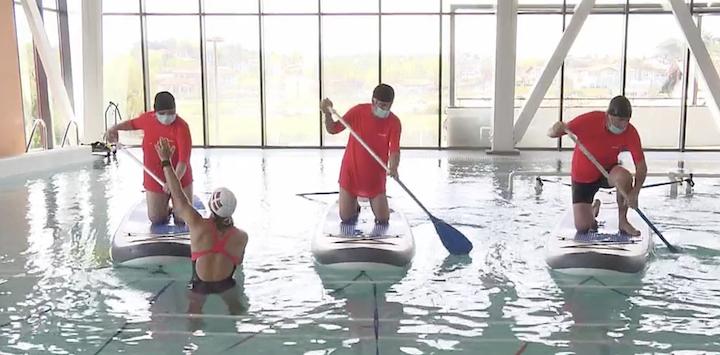In the Basque Country, sliding on the waves of the Atlantic Ocean while standing on a board is a local sport. At sea, stand-up paddleboarding is reserved for experienced people, but at the “Les Embruns” rehabilitation center, novices practice it in the swimming pool.
The idea comes from two doctors from the southwest, it is very serious since the activity has been framed for two years by a research protocol.
The paddle, a rehabilitation tool
François, Francis and Ghislaine suffer from Parkinson’s disease. The paddle is an ideal support to improve their balance and posture disorders.
Rachel Larralde, sports educator: “What is complicated is the balance, because the paddle is unstable even if it is attached and especially the muscular contractions, it requires a great effort it is not gestures that they are used to doing, that’s the hard part. “
Learning to stand up, row and play with objects while maintaining balance is an atypical activity, but not trivial. The boards, attached, will then be released as the sessions progress.
Dr François Muller, neuro-re-educator, CRF “Les Embruns”: “In the context of Parkinson’s disease, we now know that balance and posture disorders respond poorly to usual drug treatments and when Parkinson’s patients are on the paddle board, we can work and rehabilitate their instability. . The interest of this stand-up paddle activity is that it has a playful side and it can also be done in a group which is particularly important in these patients who often have a loss of motivation. “
A conclusive clinical trial
The objective is to find out whether stand up paddleboarding is as effective as physiotherapy. Jean-Louis finished the program over a year ago. That day he went to the Bayonne hospital, to see the neurologist in charge of the study.
Before and after the two months of rehabilitation, Jean-Louis underwent a battery of tests, walking and balance. The results seem significant.
Dr Olivier Flabeau, neurologist, CH Côte Basque (64): “Objective number 1 is to verify that 1 improves the balance as well as a conventional treatment which is physiotherapy. 2 that it be done in safe conditions. After that, the number of sessions and the number of sessions will have to be fine-tuned. intensity, maybe redo some consolidation sessions and see what that can be like over time and more intensive use. “
Before offering the activity to as many people as possible, the clinical trial must end, but around thirty patients must still be included.
 Cherry tomatoes contaminated with salmonella: 92 sick and 1 dead
Cherry tomatoes contaminated with salmonella: 92 sick and 1 dead  A better coaching method can make a person grow
A better coaching method can make a person grow  What is the method to prevent diabetes in children?
What is the method to prevent diabetes in children?  What are the effective factors in causing stomach ulcers?
What are the effective factors in causing stomach ulcers?  Why do embarrassing memories seem to appear at night?
Why do embarrassing memories seem to appear at night?  The amazing link between SARS-CoV-2 infection and newly started diabetes
The amazing link between SARS-CoV-2 infection and newly started diabetes  WHO says monkey pox is not a global emergency right now
WHO says monkey pox is not a global emergency right now  Single cell RNA sequencing uncovers new mechanisms of heart disease
Single cell RNA sequencing uncovers new mechanisms of heart disease  Hepatitis of unknown origin: 3 new deaths and 228 cases worldwide
Hepatitis of unknown origin: 3 new deaths and 228 cases worldwide 